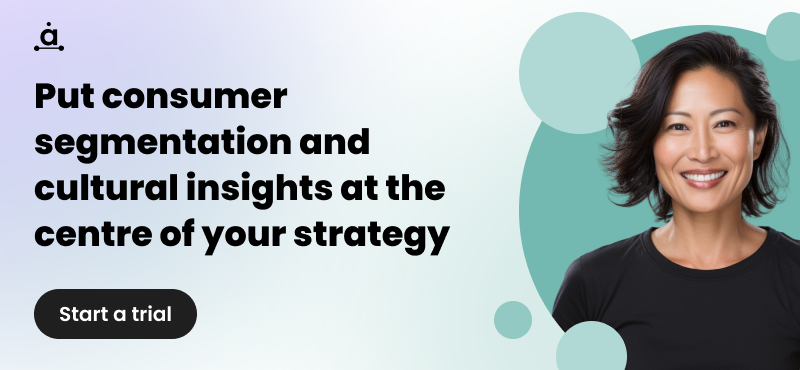Social media segmentation, but make it simple
The average person spends 2 and a half hours on social media every day.
Don’t worry if like me, you are reading this and realizing that your usage is much higher. Tik Tok has gotten very addictive…
Users post hundreds of thousands of stories, photos, and videos to social media every minute.
And maybe as the social media user, this isn’t so great for things like our mental health - but for marketers, their jobs have become so much easier.
All this real-time data on how we behave, what we like and don’t, our personalities - all of this is available to marketers.
You might be thinking what I’m thinking… then why are they still getting it wrong when they market to me? That’s a fair question.
It all comes down to how these marketers make use of our data, how they organize it and most importantly, how they segment it.
Audience segmentation is arguably the most crucial step to marketing to your audience effectively, so much so that we’ve dedicated this entire blog post to helping you get it right.
In this article we will
- Define what social media segmentation actually is
- Talk about the different levels of social media segmentation
- Show you how to segment your own audience
- And show you why once you start segmenting, you’ll never stop
Everything you need to start segmenting your social media audiences and making best use of all this social data is in here, so keep reading.
What is Social Media Audience Segmentation?
First things first - what even is social media audience segmentation?
At its core, social media segmentation is the process of dividing your social media audience into smaller, more specific groups based on shared traits - like behaviors, interests, demographics, psychographics, or even the way they interact with your brand online.
It’s kind of like being the host at a party and grouping your guests into "game lovers," "wine snobs," and "people who are going to crush all the chip dip" so you can serve each group exactly what they’ll love most… and put out enough chip dip. Metaphorically, of course.
The point is, segmenting stops marketers from treating all customers the same, and instead aims to help them understand what makes each group of customers different and special.
Why bother? Because generic content is dead.
People scroll fast and their attention spans are fleeting (I know that it’s a miracle if you’ve even made it this far in the blog).
Their feeds are curated to their exact interests, and they have zero patience for content that doesn’t feel like it was made for them. If you’re still posting one-size-fits-all content to everyone on every channel, it’s no wonder your engagement rates are tanking.
It’s easy to fall into this trap though, of assuming your audience is unison. Take for example NASCAR fans, when you say that word, I think of one specific type of person…but the NASCAR audience, like any audience is complex and made of many smaller, and very different clusters:

So you can see then why Segmented marketing is 3x more effective at driving conversions than non-segmented campaigns, and that by getting good at it, you are essentially becoming 3x better at your job.
The different levels of social media segmentation
Below are five different types of social media audience segmentation - and you don’t have to pick just one. The best marketers layer these for the most precise targeting.
Each one offers a different lens to understand and organize your audience so you can serve them better content, ads, and offers.
1. Demographic segmentation
The “what do they look like” layer.
You're looking at age, gender, income level, education, job title, marital status, and location. This is pretty basic, and please don’t rely on this alone, but I know we all like to have a psychical image of who the audience is. You could put me and my friends in the same demographic “bucket” but I assure you our passions and interests are quite different, so just keep this in mind.
Example: Targeting 25–35-year-old women in NYC who are in mid-level marketing roles.
Best for: Understanding basic audience structure, and location-specific campaigns.

2. Psychographic segmentation3. Behavioral segmentation
The “what do they care about” layer.
This digs into values, beliefs, lifestyles, personality traits, motivations, and pain points.
Example: Grouping users who are sustainability-focused, wellness-driven, and value slow living.
Best for: Messaging, tone, storytelling, influencer alignment.

3. Behavioral segmentation
The “what they do” layer.
This is based on actual actions taken on social - so what this audience likes, shares, comments, saves, clicks on, their purchase behavior, and even content bounces.
Example: Segmenting people who watched 90% of your Instagram Reels but didn’t follow you.
Best for: Retargeting, funnel optimization, conversion campaigns.

4. Interest-based segmentation
The “what they’re into” filter.
Interest based segmentation (or what we like to call Affinity segmentation here at Audiense) looks at the hobbies, passions, favorite creators, media consumed, hashtags followed, and pages liked.
Example: People who follow fashion creators, save streetwear outfit inspo, and engage with NYFW posts.
Best for: Content creation, campaign strategy, creator/influencer selection, partnerships, product positioning.

5. Platform-based (or channel-based) segmentation
Because not all social channels are created equal.
Different platforms attract different audience personalities and behaviors.
Example: Your audience on TikTok might be super casual and fun, while your LinkedIn followers want case studies and career advice.
Best for: Cross-channel strategy, tone adjustment, and picking which platform to invest in.

How to segment your own audience
Let’s be honest, this part can sound intimidating. But don’t worry - you’re not going to manually take all your user data (if you have it) and start segmenting it yourself - we live in the 21st century sweetie, we have tools for that.
Platforms like Audiense can tell you so much about who your followers are, what they care about, and how they behave online. For example, Audiense lets you run advanced segmentation based on shared affinities (like who they follow, what they talk about, and their media consumption habits).
It’s not about finding more data. You already have the data. It’s about organizing it in a way that makes your content resonate harder.
1. Define your segmentation criteria
Choose how you want to split your audience based on your goals. Here are the some options:
Demographic: Target Gen Z females in NYC

Psychographic: Target eco-conscious gym rats

Behavioral: Re-target people who clicked but didn’t convert

(all you do in this case is export that audience list and upload it into Audiense to be segmented)
Interests: Speak to fashion lovers vs. tech nerds

Channel: Tailor content for X vs. TikTok followers

All you have to do in this case is look at the followers of your brand handle.
You can mix & match these too.
For example, Audiense lets you segment by Demographics & interests: Target Gen Z females in NYC who are fashion lovers

2. Automate it
With a platform like Audience you can automate the collection of data, and automate the segmentation process.
When you know what segmentation mix you are looking, and you’ve customized that in the Audiense platform (like in step 2 above), you can now just simply launch the report and Audiense will segment that audience for you.


So if I were the brand Olipop, and I chose to segment my own Twitter audience, Audiense would segment it into as many different segments as I wanted (between 1-20), like in the image above.
3. Build personas or clusters
Now the exciting part is reviewing the different audience segments that live within your own audience. Audience automates the naming of the segments for you, based on their shared interests and behaviors.
For example:
- The Wellness Girlies: follow holistic influencers, like sunrise content, live on Instagram
- Tech Bros: engage on X, love Elon memes, retweet finance hot takes
- Aesthetic Creators: pin minimalist interiors, post Reels, care about aesthetics over utility
- Digital Marketing Founders: follow the biggest CMOs, use HubSpot and Hootsuite, like posts by Niel Patel

You can start to see how clear personas can change your perception of your audience and unearth groups you might not have even known existed until now.
4. Tailor content for each group
Now that you have segments, build content with them in mind, that’s really the whole point of segmentation.
Think of the type of content you would create for each segment based on the insights:
- Visuals: Different vibes for different tribes (i.e., pastel vs. bold neon)
- Tone of voice: More casual for Gen Z, more polished for professionals
- Topics: Give each segment the content they care about - don’t just broadcast to everyone
5. Test, track, and tweak
Segmentation isn’t a set-it-and-forget-it situation. Now it’s time to monitor:
- Which content performs best for which group
- If one audience starts to disengage
- Emerging micro-trends or shifts in behavior
Once you start, you won’t want to stop
When segmentation is done right, it’s addicting. Your engagement rates go up. Your ads feel more efficient. Your content lands harder. And your audience starts actually caring about what you post - because it feels like you get them.
It’s the difference between “meh, another brand ad” and “omg did they write this just for me?”
And honestly, isn’t that what all good marketing should feel like?
Working at Audiense, i’ve seen first hand how many brands have been able to turn things around once they started segmenting their audience - and here’s just one of those many success stories:
Audiochuck used Audiense to move beyond basic demographics and segment their podcast listeners based on psychographics, behaviors, and interests. This allowed them to personalize content, promotions, and brand partnerships to better resonate with distinct audience segments. As a result, they saw increased engagement, deeper community connections, and improved conversion rates. Audiense insights also laid the groundwork for ongoing innovation and audience growth.
Simplified segmentation
Audiense makes segmentation easy, by automating the entire process. You don’t even need to come with data on your audience, because we have that too.
Just follow the steps above and sign up for a free trial, and in no time you’ll be breaking your audience into smart little segments and creating content that actually lands.
Because let’s be real - with all the social data and tools available today, there’s no excuse to still be blasting the same content to everyone in 2025.






